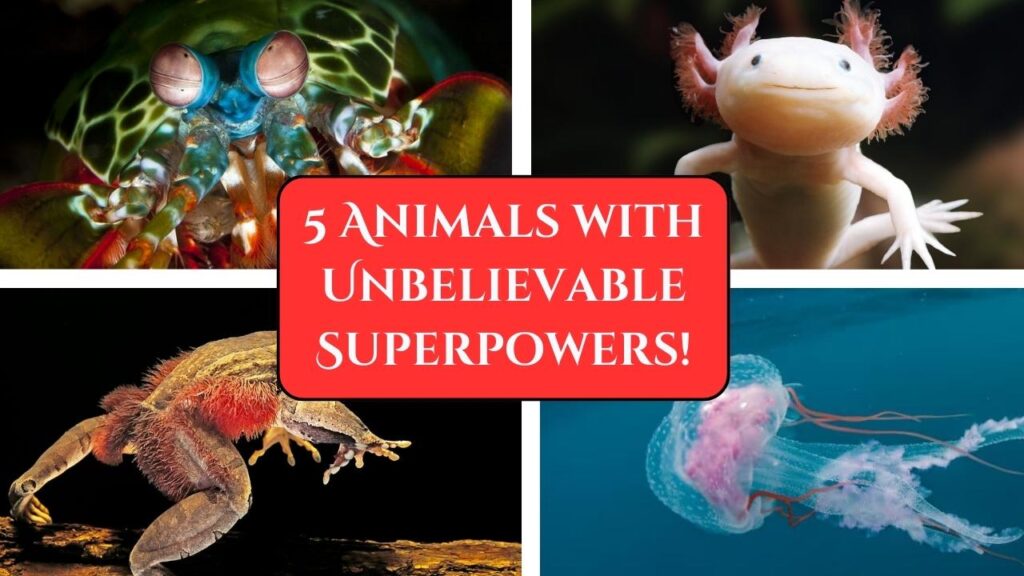
Nature never ceases to amaze us, and some animals possess abilities so remarkable they seem almost supernatural. From regenerating limbs to delivering powerful punches, these incredible creatures showcase nature’s ingenuity. In this article, we’ll explore five extraordinary animals with mind-blowing superpowers, explain how they work, and what science is learning from these fascinating abilities.
Wildlife Wonders
| Animal | Superpower | Key Fact |
|---|---|---|
| Mantis Shrimp | Ultra-fast punch | Strike speed equals a .22-caliber bullet |
| Axolotl | Limb and organ regeneration | Can regrow spinal cords and hearts |
| Pistol Shrimp | Sonic blast attack | Snap generates temperatures near 4,800°C |
| Immortal Jellyfish | Biological immortality | Reverts cells to juvenile state to avoid death |
| Hairy Frog | Bone-breaking claws | Breaks bones to produce defensive claws |
From the mantis shrimp’s powerful punch to the axolotl’s regenerative marvel, these incredible creatures demonstrate how nature’s ingenuity can inspire cutting-edge science and technology. By studying these animals, researchers are unlocking secrets that may one day revolutionize medicine, materials, and beyond.
1. Mantis Shrimp: The Power Puncher
The mantis shrimp may be small, but it packs one of the most powerful punches in the animal kingdom. Using its specialized club-like limbs, the mantis shrimp strikes with such force that it can crack glass aquariums and shatter crab shells instantly.
How Does It Work?
The mantis shrimp’s punch accelerates at 23 m/s, which is comparable to the speed of a .22-caliber bullet. This impact also creates cavitation bubbles, producing intense heat and light upon collapse. These bubbles not only add to the shrimp’s powerful strike but can also stun or kill prey.
Interesting Fact
Mantis shrimp have some of the most advanced eyesight in the animal kingdom, capable of detecting polarized light and seeing colors humans can’t even imagine.
Real-World Applications
Researchers are studying the mantis shrimp’s dactyl clubs to improve the durability of body armor and industrial materials.
2. Axolotl: The Regeneration Champion
The axolotl, a unique amphibian found in Mexico, has the rare ability to regrow lost limbs, spinal cords, and even parts of its heart and brain. This remarkable regenerative ability has made the axolotl a subject of intense medical research.
How Does It Work?
Axolotls use special cells called blastemal cells that rapidly divide and specialize into various tissues. Unlike humans, their immune system suppresses scarring, allowing perfect tissue regeneration.
Interesting Fact
Axolotls are critically endangered in the wild due to habitat destruction but are thriving in captivity due to their scientific importance.
Real-World Applications
Scientists are studying axolotls to uncover secrets that could help humans regenerate tissue, potentially revolutionizing treatments for spinal injuries and heart conditions.
3. Pistol Shrimp: The Sonic Blaster
The pistol shrimp generates a powerful sound blast that can stun or kill small fish and prey instantly. This snapping action creates a bubble that bursts with temperatures nearing 4,800°C — almost as hot as the sun’s surface.
How Does It Work?
The shrimp’s oversized claw snaps shut with immense force, creating a shockwave powerful enough to knock out nearby creatures. This rapid movement also produces a flash of light, a rare phenomenon known as sonoluminescence.
Interesting Fact
Pistol shrimp colonies are known to be incredibly noisy, often confusing sonar systems used by submarines.
Real-World Applications
Scientists are studying the pistol shrimp’s unique sound wave generation to improve underwater sonar technology and communication systems.
4. Immortal Jellyfish: The Ageless Wonder
The immortal jellyfish (Turritopsis dohrnii) has the unique ability to revert its cells to an earlier stage of development when threatened or injured, essentially turning back its biological clock.
How Does It Work?
Through a process called transdifferentiation, the jellyfish’s cells transform back into juvenile polyps, effectively bypassing death. This cycle can continue indefinitely under ideal conditions.
Interesting Fact
While technically immortal, this jellyfish can still be eaten by predators or die from disease.
Real-World Applications
While humans can’t achieve immortality, scientists are studying this jellyfish to understand cellular rejuvenation, which may offer insights into reversing aging and treating degenerative diseases.
5. Hairy Frog: The Wolverine of the Wild
Also known as the “wolverine frog,” the hairy frog (Trichobatrachus robustus) has a bizarre defense mechanism. When threatened, it deliberately breaks its own toe bones, forcing sharp claws through its skin to fend off attackers.
Uttarakhand Wildlife Animals: A Deep Dive into the Uttarakhand Most Fascinating Wildlife Animals
Explore List of Wildlife Sanctuaries in India: Detailed Insights on Area and Ecological Importance
How the Uttarakhand Wildlife Department Is Shaping the Future of Himalayan Biodiversity
How Does It Work?
When the frog’s muscles contract, its bones pierce through the skin, forming makeshift claws. Once the threat passes, the bones retract, and the tissue heals naturally.
Interesting Fact
The hairy frog is known to inhabit dense forests in Central Africa and is often difficult to spot in the wild.
Real-World Applications
This unique defense mechanism is inspiring research in self-healing materials and innovative surgical techniques.
Frequently Asked Questions (FAQs)
Q1: Are these animal superpowers rare?
Yes, these extraordinary traits are uncommon in the animal kingdom, but they have evolved to help these species survive and thrive in their respective environments.
Q2: Can humans develop abilities like these animals?
While humans cannot naturally achieve these superpowers, ongoing research into these animals is uncovering ways to enhance medicine, technology, and materials science.
Q3: Which of these abilities has the most scientific potential?
The axolotl’s regeneration ability is particularly promising for regenerative medicine, with the potential to revolutionize treatments for severe injuries and organ damage.
Q4: Are any of these animals endangered?
Yes, the axolotl is critically endangered in the wild due to habitat loss, while conservation efforts are ongoing to protect this remarkable species.










